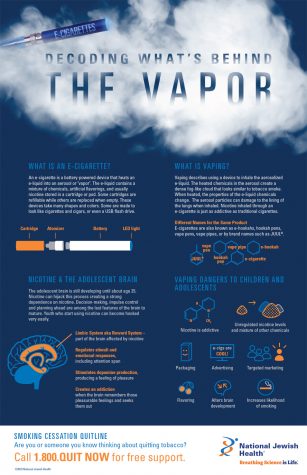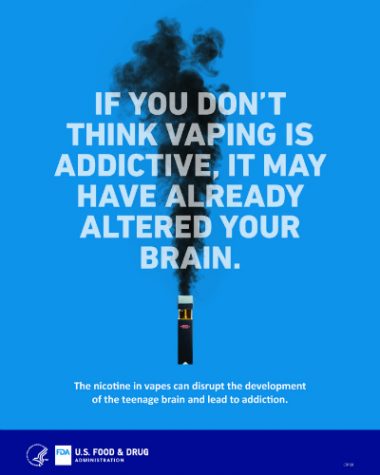Teen Vaping Reaching Epidemic Proportions
2.1 million middle and high school students were e-cigarette users in 2017. That number has risen from 3.6 million in 2018 to 5.4 million in 2019. It’s safe to say that vaping has reached epidemic proportions. E-cigarettes are now the most frequently used tobacco product among adolescents. And after recent unexplained illnesses and deaths that have been a credit to vaping, the CDC (Centers for Disease Control and Prevention) and the American Medical Association are expressing serious concern, recommending that people should avoid vaping entirely.

So, what is vaping? Vaping originated as a smoking substitute that has now become popular and addictive. Vaping is the act of inhaling and exhaling vapor from heated nicotine called “juice”. A JUUL (a form of e-cigarette) is a popular brand among e-cigarettes. It looks like a flash drive and can be charged through a USB port. Sarper Taskiran, MD, a child and adolescent psychiatrist at the Child Mind Institute, blames the recent rise in popularity to packaging and advertising targeting teens: “The teens are after innovation and they’re attracted by sleek design and ease of use,” he says. “They look like an Apple product.” Vaping companies try to entice adolescents by saying it will make you happier and will improve your social status.
The legal age to buy an e-cigarette is 18 which means it is illegal for a retailer to sell a tobacco product to anyone under the age of 18 but, a new law approved by Congress and signed by the president is raising the age of selling tobacco products (including e-cigarettes) from 18 to 21. 19 states raised the age in 2019. At the beginning of 2020, Oklahoma became one of those states after passing Senate Bill 1423. This law was created because students typically don’t reach 21 while in high school. Raising the age will decrease the number of high school students who purchase these products.
But there are already many known risks related to vaping. E-cigs contain high amounts of nicotine which can make them extremely addictive. One JUUL pod (the container which holds “juice” and is placed into the rechargeable battery portion) is the equivalent of one pack of cigarettes. Teens are an easy target for addiction since their brains are still developing, which makes them more likely to turn to drugs and alcohol than adults. Vaping can impact teens’ focus: “Dr. Taskiran has observed this with the adolescents he works with, who report that vaping initially increases their alertness and attention, but then [they] experience a decrease in attention span.” A recent study has found increased levels of carcinogens in the urine of teens who vape. Carcinogens promote the formation of cancer. E-cigarettes cause lung irritation and damage to vital immune system cells; Increases heart rate and blood pressure, which can increase circulatory (circulation of blood) problems. Teens who vape are more likely to start smoking.

What can be done? First, begin by educating yourself so you’re aware of the risks involved. Second, if you are addicted to an e-cigarette or any other tobacco product, consult a clinician who knows addiction treatment options. Just know that there are solutions so don’t be afraid to ask for help from a parent or other trusted adult. Follow the links below from the Child Mind Institute, statistics from the CDC, the recent vaping restrictions by the American Lung Association, and KFOR’s report on Oklahoma’s recent Tobacco 21 law to find out more about the teen vaping crisis.
https://childmind.org/article/teen-vaping-what-you-need-to-know/
https://www.cdc.gov/tobacco/data_statistics/fact_sheets/youth_data/tobacco_use/index.htm
https://www.lung.org/our-initiatives/tobacco/cessation-and-prevention/tobacco-21-laws.html






